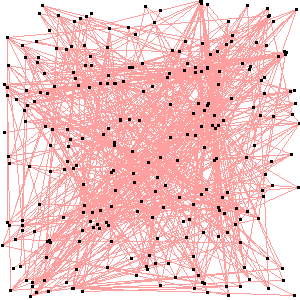Ley line
Ley lines are alignments of a number of places of geographical interest, such as ancient megaliths. They were first observed in 1921 by the amateur archaeologist Alfred Watkins, whose book The Old Straight Track first brought the phenomenon to the attention of the wider public.
The existence of these apparently remarkable alignments between sites is easily demonstrated. However, the causes of these alignments are disputed. There are three major schools of thought:
- Anthopological: According to proponents of some ley line theories, the early inhabitants of Great Britain determined the placement of Stonehenge and various other megalith structures, buildings, monuments, or mounds according to a system of these lines, which often pass through, or near, several such structures. Some of these theories believe leys to have had some astronomical significance, or to relate to traditional religious beliefs associated with these sites. Others simply see leys as marking trade routes.
- New Age: Some have claimed that these points resonate a special psychic energy. These theories often include elements such as geomancy, dowsing or UFOs. Some others believe that these points may have electrical or magnetic forces associated with them.
- Skeptical: Skeptics of these ley line theories believe that they belong in the realms of pseudoscience or magic (or magick). Most skeptics believe that ley lines can be explained completely by chance alignments that appear intuitively unlikely, but can be demonstrated to be unsurprising coincidences.
The anthropological approach: Alfred Watkins and The Old Straight Track
The concept of ley lines was first propounded by Alfred Watkins. On June 30, 1921, Watkins visited Blackwardine in Herefordshire, and went riding around near some hills in the vicinity of Bredwardine when he noted many of the footpaths therein seemed to connect one hilltop to another in a straight line. He was studying a map when he noticed that a number of significant places were in alignment. "The whole thing came to me in a flash," he would later explain to his son. Watkins believed that in ancient times, when Britain had been far more densely forested, the country had been crisscrossed by a network of straight-line travel routes, with prominent features of the landscape being used as navigation points. This chance observation led him onto a line of theorising which he made public at a meeting of the Woolhope Club of Hereford in September 1921. His work refered back to G. H. Piper's paper presented to the Woolhope Club in 1882 which noted that
- "A line drawn from the Skirrid-fawr mountain northwards to Arthur's Stone would pass over the camp and southern most point of Hatterill Hill, Oldcastle, Longtown Castle, and Urishay and Snodhill castles."
Watkins published his ideas in the books Early British Trackways and The Old Straight Track; however, they were received with skepticism in the archaeological community. The archaeologist O. G. S. Crawford refused to accept advertisements for the latter in the journal Antiquity, and most archaeologists since then have continued to be dismissive of his ideas.
The ancient surveyors who supposedly made the lines were given the name "dodmen".
The discovery of the Nazca lines, which demonstrated easily observable man-made long straight tracks on the plains of Peru, caused a resurgence of interest in anthropological explanaions of ley lines in the 1970s.
The New Age approach: magical and holy lines
Watkins' theories have been expanded and adapted by later writers. Some of his ideas were taken up by the occultist Dion Fortune who featured them in her 1936 novel The Goat-footed God. Since then, ley lines have become the subject of many magical and mystical theories.
The two British dowsers, Captain Robert Boothby and Reginald Smith of the British Museum have linked the appearence of ley-lines with underground streams, and magnetic currents. Ley-spotter / Dowser Underwood conducted various investigations and claimed that crossings of 'negative' water lines and positive aquastats explain why certain sites were chosen as holy. He found so many of these 'double lines' on sacred sites that he named them 'holy lines.'
Nazi researchers Wilhelm Teudt and Josef Heinsch have also claimed that ancient Teutonic peoples contributed to the construction of a network of astronomical lines, called “Holy lines” (Heilige linien), which could be mapped onto the geographical layout of ancient or sacred sites. Teudt located the Teutoburger Wald district in Lower Saxony, centered around the dramatic rock formation called Die Externsteine as the centre of Germany.
By the 1960s, the ideas of a landscape crossed with straight lines had become conflated with ideas from various geomantic traditions; mapping ley lines, according to New Age geomancers, can foster "harmony with the Earth" or reveal pre-historic trade routes. John Michell's writing can be seen as an example of this. He has referred to the whole face of China being heavily landscaped in accordance with the laws of Feng Shui. Michell has claimed that Neolithic peoples recognised that the harmony of society depend on the harmony of the earth force. And so in China, ancient Greece and Scotland men built their temples where the forces of the earth were most powerful.
The skeptical approach: chance alignments
Some skeptics have suggested that ley lines are a product of human fancy. Watkins' discovery happened at a time when Ordnance Survey maps were being marketed for the leisure market, making them reasonably easy and cheap to obtain; this may have been a contributing factor to the popularity of ley line theories.
One suggestion is that thanks to the high density of historic and prehistoric sites in Britain and other parts of Europe, that finding straight lines that "connect" sites (usually selected to make them "fit") is trivial, and may be easily ascribed to coincidence.
Regarding the trade route theories, skeptics point out that straight lines do not make ideal roads in all circumstances, particularly where they ignore topography and require users to march up and down hills or mountains, or to cross rivers at points where there is no ford or bridge.
Are alignments and ley lines the same thing?
The existence of the observed alignments is not controversial. Both believers in magical and ancient theories of ley lines and skeptics of these theories agree that these alignments exist between megaliths and ancient sites.
The major disagreement between the two camps is that most skeptics believe that their null hypothesis of ley-line-like alignments being due to random chance is consistent with all known evidence. They believe that this removes the need to explain these alignments in any other way. Proponents of ley line theories believe that further theories are needed to explain the observed evidence. See hypothesis testing, falsifiability and Occam's razor for more on these topics.
For discussing the arguments for and against the chance presence of ley line alignments it is useful to define the term "alignment" precisely enough to reason about it. One precise definition which expresses the generally accepted meaning of Watkins' ley lines defines an alignment as:
- a set of points, chosen from a given set of landmark points, all of which lie within at least one straight path of a given width w
One simple definition of "straight path of width w" is the set of all points within a distance of w/2 of a straight line on a plane, or a great circle on a sphere, or in general any geodesic on any other kind of manifold. Note that in general an uncountable number of infinitesimally different straight paths will contain any given set of points that are aligned in this way, so only the existence of at least one straight path is important to consider whether a set of points is an alignment. For this reason, it is easier to count the sets of points, rather than the paths themselves.
The width w is important: it allows the fact that real-world features are not mathematical points, and that their positions need not line up exactly for them to be considered in alignment by ley line theorists.
Using a 1mm pencil line on an 50000:1 Ordnance Survey map, w would be 50m. Where larger geographical features such as towns are to be aligned, w may be as much as 1km, since a town centre is often greater than 1km in size.
Using this definition, the existence of these alignments can be discussed without prejudicing the issue of whether these alignments are due to chance, Earth forces, ancient builders or other causes.
Can chance alone explain ley lines?
Computer simulations show that points on a plane tend to form alignments similar to those found by Watkins, suggesting that his ley lines may also be generated by chance. This phenomenon occurs regardless of whether the points are generated pseudo-randomly by computer, or from data sets of non-magical features such as pizza restaurants.
Statistically, finding alignments on a landscape gets progressively easier as the area to be considered increases. One way of understanding this phenomenon is to see that the increase in the number of possible combinations of points in that area overwhelms the decrease in the probability that any given set of points in that area line up.
The number of alignments found is very sensitive to the allowed width w, increasing approximately proportionately to wk-2, where k is the number of points in an alignment.
It is easy to find alignments of 4 to 8 points in reasonably small data sets with w = 50m. Choosing large areas or larger values of w makes it easy to find alignments of 20 or more points.
What evidence would it take to persuade skeptics to think again?
The demonstration of the plausibility of the current evidence under the null hypothesis is not a formal disproof of ley line claims. However, it does make skeptics unlikely to consider ley line theories as valid without further evidence.
Most skeptics would be willing to reconsider the hypothesis of ley lines if there was non-anecdotal evidence of physical, geomagnetic or archeological features that actually lay along the paths of ley lines. So far, no such convincing evidence has been presented.
Scientific investigation
According to data obtained by investigators of ley line theories, some ley lines points possess higher magnetic energy than the average geomagnetic intensity. Theories of magnetic interaction at ley line points suggest to some observers that these points were used to induct energy. Some geomatic researchers have investigated this phenomenon by studying telluric currents, geomagnetism, and the Schumann resonance (among other physical phenomenon). Current data is inconclusive.
See also:
Compare with:
- Earth mysteries
- The Bible Code
- Feng shui
- Ark of the Covenant (related in some theories to the idea of ancient people using electromagnetic energy)
References
- Alfred Watkins, Early British Trackways (1922)
- Alfred Watkins, The Old Straight Track (1925)
- Alfred Watkins, The Ley Hunter's Manual (1927)
- Tony Wedd, Skyways and Landmarks (1961)
- Williamson, T. and Bellamy, L., Ley Lines in Question. (1983)
External links
- A ley line map
- http://www.magonia.demon.co.uk/arc/80/leyhistory.html
- The Ley Line Mystery
- Ley Lines and Coincidence: discussion and computer simulation results
- Skeptic's Dictionary entry on Ley Lines
- DMOZ geomatics
- GIS and Remote sensing site


